- CAC Antibody Collection Index Page
Antibody Group
Advanced glycation end products (AGEs)
Autophagy and apoptosis
Bacteria-related
Calcium-binding proteins
Cancer
CD44 for enriching cancer stem cells
Tumor markers
Tumor inhibitors
Chaperones
Cytoskeleton
DNA damage
UV-induced DNA lesions
8-Nitroguanosine for oxidative stress research
Nucleotide excision repair factors
Epigenetics and chromatin
Histone H3 variants
Post-translationally-modified histone H3
Chromatin structure modifiers
Drosophila chromatin
Epitope tags
Exosomes
Extracellular matrix
Glycosaminoglycans (GAGs)
Proteoglycans
Matrix and basement membrane
Cell adhesion and hemidesmosome-related
Bone and cartilage-related
Wound repair-related
Hedgehog pathway
Hormones
Immunology
Fish CD4 and CD8α
Allergic disease-related
Adaptive and innate immunity
Macrophages
Inflammatory cytokines
Viral recognition pathways
Vpr for HIV research
Insulin-like growth factor-related
Mitochondria-related
Neurobiology
Neurodegenerative disease markers
Muscarinic acetylcholine receptors
Miscellaneous
Nuclear import and export
Oxidative stress
Plant-related
Plant hormones
Plant autophagy and apoptosis
Plant stress response
Plant stress response
Proteasomes
Puromycin-specific
Reproductive biology
Small molecules
Stem cells
Novel iPS/ES markers
Pluripotency-associated
Sumoylation pathway
TGF-beta pathway
TGF-beta LAP-d
TGF-beta signaling
Transcription factors
Transporters
Tyrosine phosphatases
Ubiquitin-Proteasome Related
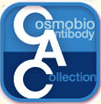 CAC Antibody Collection
CAC Antibody Collection
The antibodies on this page are part of Cosmo Bio's exclusive CAC Collection. For many many thousands of other antibodies from many different makers, use our Search the Store function and our Explore Products drop down menu.
Reproductive Biology
| In the sexual reproductive cycle, haploid generations of cells, each carrying a single set of chromosomes, alternate with diploid generations of cells, each carrying a double set of chromosomes. Genomes mix when two haploid cells fuse to form a diploid cell. Later, new haploid cells are generated when a descendant of this diploid cell divides by the process of meiosis. During meiosis, the chromosomes of the double chromosome set exchange DNA by genetic recombination before being shared out, in new combinations, into single chromosome sets. Because each single chromosome set will contain genes originating from one ancestral cell of the previous haploid generation mixed with genes from the other ancestral cell, each cell of the new haploid generation will receive a novel assortment of genes. Thus, through cycles of haploidy, cell fusion, diploidy, and meiosis, old combinations of genes are broken up and new combinations are created. [from: Alberts B, Johnson A, Lewis J, et al. Molecular Biology of the Cell. 4th edition. New York: Garland Science; 2002. The Benefits of Sex. Available from: https://www.ncbi.nlm.nih.gov/books/NBK26823/] |
|
| Product name | Anti Inhibin Alpha Chain (INHA) mAb |
| Cat No | CAC-KZ-HS-M01 |
| Description | Inhibin is an endocrine hormone produced in the ovaries, the testes and the placenta. This hormone has several functions in the body, with inhibin levels in women being linked to the menstrual cycle and playing a role in fetal development. Another hormone, activin, has an action in the body opposite to that of inhibin. Levels of these two hormones tend to fluctuate in both men and women in response to a number of cues which can include changes in hormone levels triggered by natural biological processes, environmental pressure, and other factors. References: 1) Miyamoto K, Hasegawa Y, Fukuda M, Nomura M, Igarashi M, Kangawa K & Matsuo H (1985) Isolation of porcine follicular fluid inhibin of 32K daltons. Biochem Biophys Res Commun 129:396-403. PMID: 4015638 2) Miyamoto K, Hasegawa Y, Fukuda M & Igarashi M (1986) Demonstration of high molecular weight forms of inhibin in bovine follicular fluid (bFF) by using monoclonal antibodies to bFF32K inhibin. Biochem Biophys Res Commun 136: 1103-1109. PMID: 3718497 |
| Host | MS |
| Species specificity | BOV |
| Figure 1 | 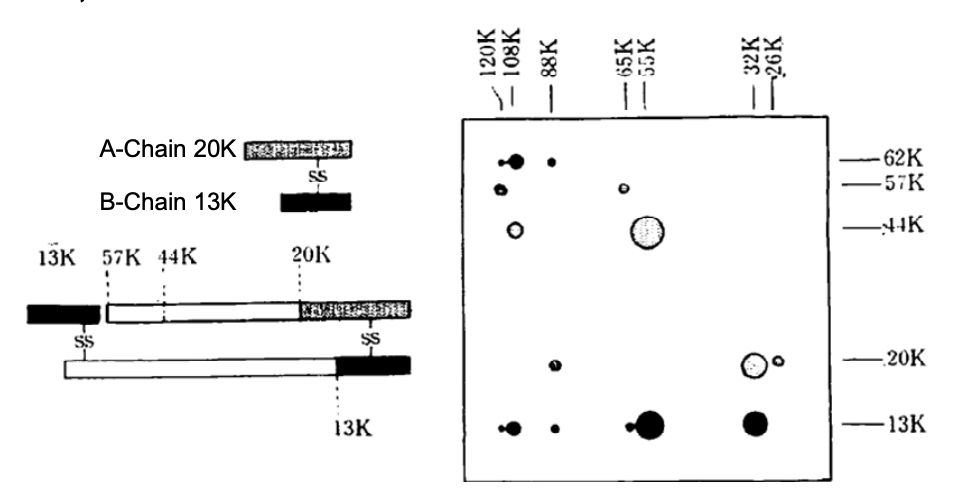 |
| Product name | Anti Inhibin Beta A Chain (EDF) mAb |
| Cat No | CAC-KZ-HS-M02 |
| Description | Inhibin is an endocrine hormone produced in the ovaries, the testes and the placenta. This hormone has several functions in the body, with inhibin levels in women being linked to the menstrual cycle and playing a role in fetal development. Another hormone, activin, has an action in the body opposite to that of inhibin. Levels of these two hormones tend to fluctuate in both men and women in response to a number of cues which can include changes in hormone levels triggered by natural biological processes, environmental pressure, and other factors. References: 1) Miyamoto K, Hasegawa Y, Fukuda M, Nomura M, Igarashi M, Kangawa K & Matsuo H (1985) Isolation of porcine follicular fluid inhibin of 32K daltons. Biochem Biophys Res Commun 129:396-403. PMID: 4015638 2) Miyamoto K, Hasegawa Y, Fukuda M & Igarashi M (1986) Demonstration of high molecular weight forms of inhibin in bovine follicular fluid (bFF) by using monoclonal antibodies to bFF32K inhibin. Biochem Biophys Res Commun 136: 1103-1109. PMID: 3718497 |
| Host | MS |
| Species specificity | HU MS RT BOV SH |
| Figure 1 |  |
| Product name | Anti Gonadotropin-Releasing Hormone I (GnRH-ILH-RH I) pAb (Rabbit, Antiserum) |
| Cat No | CAC-KZ-HS-P01 |
| Description | Gonadotropin Releasing Hormone (GnRH), also know as Luteinizing-hormone-releasing-hormone (LHRH) and luliberin, is a tropic peptide hormone responsible for the release of follicle-stimulating hormone (FSH) and Luteinizing Hormone (LH) from the anterior pituitary. GnRH is synthesized and released from neurons within the hypothalamus. The peptide belongs to gonadotropin-releasing hormone family. References: 1) Hasegawa Y, Miyamoto K, Yazaki C & Igarashi M (1981) Regulation of the second surge of follicle-stimulating hormone; effects of antiluteinizing hormone-releasing hormone serum and pentobarbital. Endocrinology. 109: 130-135. PMID: 6786859 2) Sakai T, Inoue K, Hasegawa Y & Kurosumi K (1988) Effect of passive immunization to gonadotropin-releasing hormone(GnRH)using GnRH antiserum on the mitotic activity of gonadotrophs in castrated male rats. Endocrionology. 122: 2803−2808. PMID: 3131126 |
| Host | RAB |
| Species specificity | HU MS RT BOV SH |
| Figure 1 |  |
| Product name | Anti Avian Gonadotropin-Releasing Hormone I (GnRH-ILH-RH I) pAb (Rabbit, Antiserum) |
| Cat No | CAC-KZ-HS-P02 |
| Description | Gonadotropin Releasing Hormone (GnRH), also know as Luteinizing-hormone-releasing-hormone (LHRH) and luliberin, is a tropic peptide hormone responsible for the release of follicle-stimulating hormone (FSH) and Luteinizing Hormone (LH) from the anterior pituitary. GnRH is synthesized and released from neurons within the hypothalamus. The peptide belongs to gonadotropin-releasing hormone family. References: 1) Miyamoto K, Hasegawa Y, Minegishi T, Nomura M, Takahashi Y & Igarashi M (1982) Isolation and characterization of chicken hypothalamic luteinizing hormone-releasing hormone. Biochem Biophys Res Commun. 107: 820-827. PMID: 6814432 2) Mikami S, Yamada S, Hasegawa Y & Miyamoto K (1988) Localization of avian LHRH-immunoreactive neurons in the hypothalamus of the domestic fowl, Gallus domesticus, and the Japanese quail, Coturnix coturnix. Cell Tiss Res. 251: 51-58. PMID: 3277716 |
| Host | RAB |
| Species specificity | Avian CHK |
| Figure 1 | 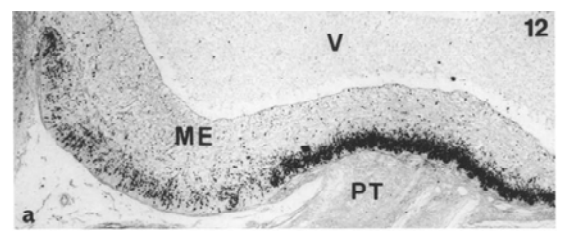 |
| Figure 2 |  |
| Product name | Anti Gonadotropin-Releasing Hormone II (GnRH IILH-RH II) pAb (Rabbit, Antiserum) |
| Cat No | CAC-KZ-HS-P03 |
| Description | Gonadotropin Releasing Hormone (GnRH), also know as Luteinizing-hormone-releasing-hormone (LHRH) and luliberin, is a tropic peptide hormone responsible for the release of follicle-stimulating hormone (FSH) and Luteinizing Hormone (LH) from the anterior pituitary. GnRH is synthesized and released from neurons within the hypothalamus. The peptide belongs to gonadotropin-releasing hormone family. References: 1) Miyamoto K, Hasegawa Y, Nomura M, lgarashi M, Kangawa K & Matsuo H (1984) Identification of the second gonadotropin-releasing hormone in chicken hypothalamus: evidence that gonadotropin secretion is probably controlled by two distinct gonadotropin-releasing hormones in avian species. Proc Natl Acad Sci USA. 81: 3874-3878. PMID: 6427779 2) Amano M, Oka Y, Aida K, Okumoto N, Kawashima S & Hasegawa Y (1991) Immunocytochemical demonstration of salmon GnRH and chicken GnRH-II in the brain of masu salmon, Oncorhynchus masou. J Comp Neurol. 314: 587-597. PMID: 1814976 3) Kobayashi M, Amano M, Kim MH, Furukawa K, Hasegawa Y & Aida K (1994) Gonadotropin-releasing hormones of terminal nerve origin are not essential to ovarian development and ovulation in goldfish. Gen Com Endocrinol. 95: 192-200. PMID: 7958749 4) Ishizaki M, Iigo M, Yamamoto N & Oka Y (2004) Different modes of gonadotropin-releasing hormone (GnRH) release from multiple GnRH systems as revealed by radioimmunoassay using brain slices of a teleost, the dwarf gourami (Colisa lalia). Endocrinology. 145: 2092-2103. PMID: 14715708 |
| Host | RAB |
| Species specificity | CHK |
| Figure 1 | 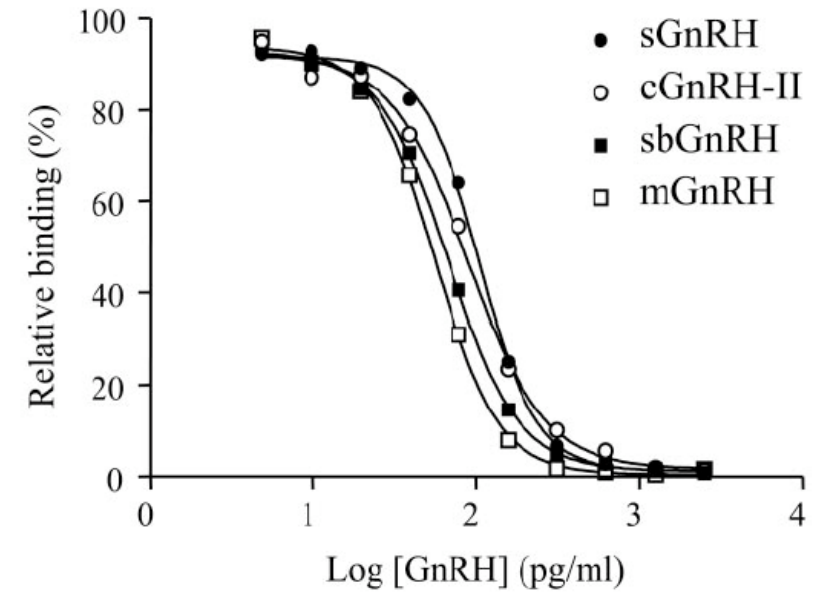 |
| Product name | Anti des-pyroGlu-Gonadotropin-Releasing Hormone II (GnRH IILH-RH II) pAb (Rabbit, Antiserum) |
| Cat No | CAC-KZ-HS-P04 |
| Description | Gonadotropin Releasing Hormone (GnRH), also know as Luteinizing-hormone-releasing-hormone (LHRH) and luliberin, is a tropic peptide hormone responsible for the release of follicle-stimulating hormone (FSH) and Luteinizing Hormone (LH) from the anterior pituitary. GnRH is synthesized and released from neurons within the hypothalamus. The peptide belongs to gonadotropin-releasing hormone family. References: 1) Miyamoto K, Hasegawa Y, Nomura M, lgarashi M, Kangawa K & Matsuo H (1984) Identification of the second gonadotropin-releasing hormone in chicken hypothalamus: evidence that gonadotropin secretion is probably controlled by two distinct gonadotropin-releasing hormones in avian species. Proc Natl Acad Sci USA. 81: 3874-3878. PMID: 6427779 2) Amano M, Oka Y, Aida K, Okumoto N, Kawashima S & Hasegawa Y (1991) Immunocytochemical demonstration of salmon GnRH and chicken GnRH-II in the brain of masu salmon, Oncorhynchus masou. J Comp Neurol. 314: 587-597. PMID: 1814976 3) Kobayashi M, Amano M, Kim MH, Furukawa K, Hasegawa Y & Aida K (1994) Gonadotropin-releasing hormones of terminal nerve origin are not essential to ovarian development and ovulation in goldfish. Gen Com Endocrinol. 95: 192-200. PMID: 7958749 |
| Host | RAB |
| Species specificity | Vert CHK |
| Figure 1 |  |
| Figure 2 | 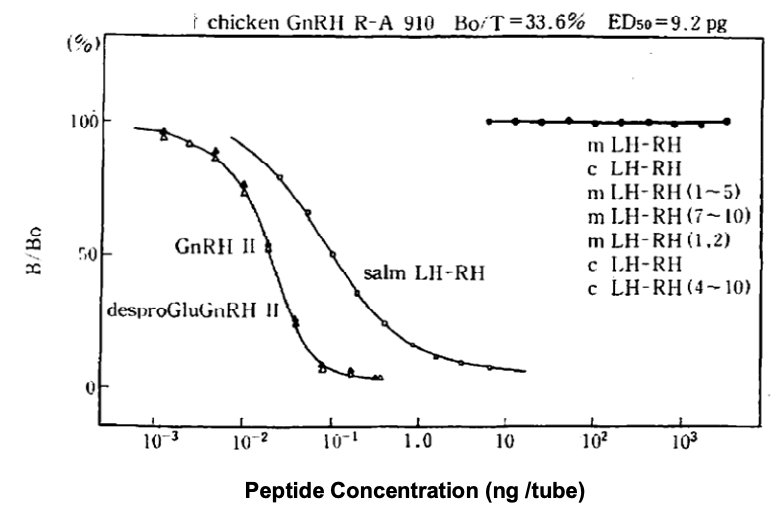 |
| Product name | Anti Inhibin Alpha Chain pAb (Goat, Antiserum) |
| Cat No | CAC-KZ-HS-P05 |
| Description | Inhibin is an endocrine hormone produced in the ovaries, the testes and the placenta. This hormone has several functions in the body, with inhibin levels in women being linked to the menstrual cycle and playing a role in fetal development. Another hormone, activin, has an action in the body opposite to that of inhibin. Levels of these two hormones tend to fluctuate in both men and women in response to a number of cues which can include changes in hormone levels triggered by natural biological processes, environmental pressure, and other factors. References: 1) Hasegawa Y, Madarame H & Ibuki Y (1995) Inhibin and activin: Novel regulators for gonadal function and sexual maturation. Eds. Hibi I and Tanaka T, in: Sexual Differentiation and Maturation, P. 139-154, Ares Serono Symposia Publications 2) Kaneko H, Taya K, Watanabe G, Noguchi J, Kikuchi K, Shimada A & Hasegawa Y (1997) Inhibin is involved in the suppression of FSH secretion in the growth phase of the dominant follicle during the early luteal phase in cows. Domestic Ani Endocrinol. 14: 263-271. PMID: 9260064. 3) Hasegawa Y, Madarame H, Yoshida S, Kaneko H, Abe Y, Mizunuma H & Ibuki Y (1997) Two-site immunoassay for native inhibin A. Eds. Aono T, Sugino H and Vale W. in: Inhibin, Activin and Follistatin, P. 104-117, Springer-Verlag 4) Kaneko H, Noguchi J, Kikuchi K, Akagi S, Shimada A, Taya K, Watanabe G & Hasegawa Y (2001) Production and endocrine role of inhibin during the early development of bull calves. Biol Reprod. 65: 209-215. PMID: 11420242 5) Kaneko H, Noguchi J, Kikuchi K, Todoroki J & Hasegawa Y (2002) Alterations in peripheral concentrations of inhibin A in cattle studied using a time-resolved immunofluorometric assay: Relationship with estradiol and follicle-stimulating hormone in various reproductive conditions. Biol Reprod. 67: 38-45. PMID: 12079997 6) Kaneko H and Hasegawa Y (2007) Application of time-resolved fluorometry to immunoassays for bovine reproductive hormones. Ani Sci J. 78: 7-15. |
| Host | GT |
| Species specificity | HU MS RT BOV SH |
| Figure 1 | 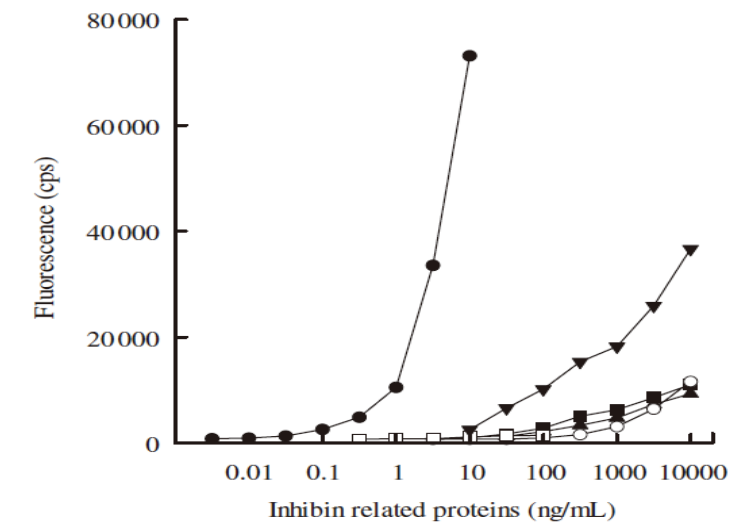 |
| Dose-response curves of various Inhibin-related proteins in time-resolved fluoroimmunoassays for Inhibin A. Materials tested were 32 kDa Inhibin A (closed circle), Activin A (closed triangle), Activin AB (closed square), Activin B (open circle), pro-AlphaC (inverted closed triangle) purified from bovine follicular fluid, and human recombinant Inhibin B (open square). Modified from Kaneko et al. (2002a) | |
| Product name | Anti Inhibin Beta A Chain (EDF) pAb (Rabbit, Antiserum) |
| Cat No | CAC-KZ-HS-P06 |
| Description | Inhibin is an endocrine hormone produced in the ovaries, the testes and the placenta. This hormone has several functions in the body, with inhibin levels in women being linked to the menstrual cycle and playing a role in fetal development. Another hormone, activin, has an action in the body opposite to that of inhibin. Levels of these two hormones tend to fluctuate in both men and women in response to a number of cues which can include changes in hormone levels triggered by natural biological processes, environmental pressure, and other factors. References: 1) Miyamoto K, Hasegawa Y, Fukuda M, Nomura M, Igarashi M, Kangawa K & Matsuo H (1985) Isolation of porcine follicular fluid inhibin of 32K daltons. Biochem Biophys Res Commun 129: 396-403. PMID: 4015638 2) Miyamoto K, Hasegawa Y, Fukuda M & Igarashi M (1986) Demonstration of high molecular weight forms of inhibin in bovine follicular fluid (bFF) by using monoclonal antibodies to bFF32K inhibin. Biochem Biophys Res Commun 136: 1103-1109. PMID: 3718497 |
| Host | RAB |
| Species specificity | MS RT BOV SH |
| Product name | Anti Inhibin pAb (Rabbit, Antiserum) |
| Cat No | CAC-KZ-HS-P07 |
| Description | Inhibin is an endocrine hormone produced in the ovaries, the testes and the placenta. This hormone has several functions in the body, with inhibin levels in women being linked to the menstrual cycle and playing a role in fetal development. Another hormone, activin, has an action in the body opposite to that of inhibin. Levels of these two hormones tend to fluctuate in both men and women in response to a number of cues which can include changes in hormone levels triggered by natural biological processes, environmental pressure, and other factors. References: 1. Hasegawa Y, Miyamoto K, Fukuda M, Takahashi Y & Igarashi M. (1986) Immunological study of ovarian inhibin. Endocrinol Jpn. 33: 645-654. PMID: 3104019. |
| Host | RAB |
| Species specificity | MS RT SH POR |
| Figure 1 |  |
| Displacement curves of inhibin preparations from various sources in RIA systems. The curves were linealized by the methods of least squares on logarithmic amounts of the preparations versus logit (B/Bo). a; pFF 32kDa inhibin, b; partially purified inhibin by gel filtration, c; partially purified inhibin by Matrix gel RedA, d; pFF, e; bFF 32KDa inhibin, f; bFF, g; hFF, h; rat ovarian extract. | |
| Product name | Anti Follistatin (FS) pAb (Rabbit, Antiserum) |
| Cat No | CAC-KZ-HS-P08 |
| Description | Follistatin also known as activin-binding protein is a protein that in humans is encoded by the FST gene. Follistatin is an autocrine glycoprotein that is expressed in nearly all tissues of higher animals. It was initially isolated from follicular fluid and was identified as a protein fraction that inhibited follicle-stimulating hormone (FSH) secretion from the anterior pituitary, and so was known as FSH-suppressing protein (FSP). Since then its primary function has been determined to be the binding and bioneutralization agent of members of the TGF- β superfamily, with primary focus on activin. References: 1) Hasegawa Y, Eto Y, Ibuki Y and Sugino H. (1994) Activin as autocrine and paracrine factor in the ovary. Horm Res. 41(Suppl 1):55- |
| Host | RAB |
| Species specificity | BOV MS RT |
| Figure 1 | 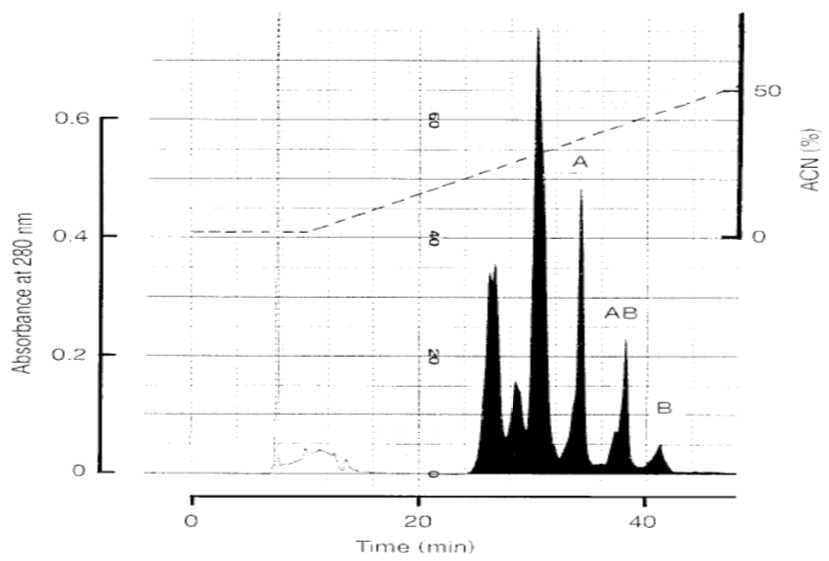 |
| Elution profile on reverse-phase HPLC of the partially purified activin-follistatin complex of fraction 2 in figure 6 apples to a Sosmosil 5 C18-AR column (10 x 250 mm). The column was developed with the indicated gradient of acetonitrile (ACN) in 0.1% try-fluoroacetic aside. | |
| Product name | Anti Progesterone pAb (Rabbit, Antiserum) |
| Cat No | CAC-KZ-HS-P13 |
| Description | Progesterone is produced in the ovaries (to be specific, after ovulation in the corpus luteum), the adrenal glands (near the kidney), and, during pregnancy, in the placenta. Progesterone is also stored in adipose (fat) tissue.In humans, increasing amounts of progesterone are produced during pregnancy. References: 1) 長谷川喜久 (1988) 内分泌試験 (各種ホルモンの抗体作製法) 佐久間勇次 監修 ウサギ− 生殖生理と実験手技 P.201-216、近代出版 |
| Host | RAB |
| Species specificity | HU MS RT BOV CHK |
| Product name | Anti Testosterone pAb (Rabbit, Antiserum) |
| Cat No | CAC-KZ-HS-P14 |
| Description | Testosterone is a steroid hormone from the androgen group and is found in mammals, reptiles, birds, and other vertebrates. In mammals, testosterone is primarily secreted in the testes of males and the ovaries of females, although small amounts are also secreted by the adrenal glands. It is the principal male sex hormone and an anabolic steroid. In men, testosterone plays a key role in the development of male reproductive tissues such as the testis and prostate as well as promoting secondary sexual characteristics such as increased muscle, bone mass and the growth of body-hair. References: 1) 長谷川喜久 (1988) 内分泌試験 (各種ホルモンの抗体作製法) 佐久間勇次 監修 ウサギ− 生殖生理と実験手技 P.201-216、近代出版 |
| Host | RAB |
| Species specificity | HU MS RT BOV CHK |
| Product name | Anti Androstenedione pAb (Rabbit, Antiserum) |
| Cat No | CAC-KZ-HS-P15 |
| Description | Androstenedione is the common precursor of male and female sex hormones. Some androstenedione is also secreted into the plasma, and may be converted in peripheral tissues to testosterone and estrogens. Androstenedione can be synthesized in one of two ways. The primary pathway involves conversion of 17-hydroxypregnenolone to dehydroepiandrosterone by way of 17,20-lyase, with subsequent conversion of dehydroepiandrosterone to androstenedione via the enzyme 3-β-hydroxysteroid dehydrogenase. References: 1) 長谷川喜久(1988) 内分泌試験 (各種ホルモンの抗体作製法) 佐久間勇次 監修 ウサギ− 生殖生理と実験手技 P.201-216、近代出版 |
| Host | RAB |
| Species specificity | HU MS RT BOV CHK |
